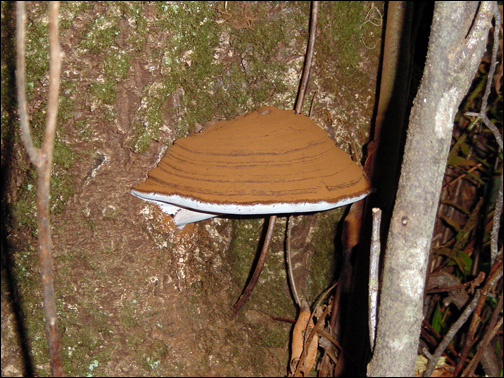
by Susan Labiste
Other Successful Attempts at Producing Amadou

Artist Conk (Ganoderma applanatum)
Not every attempt to produce Ganoderma amadou was successful, and none performed as spectacularly as the oak conk. In fact, the performance of the Ganoderma appalanatum amadou was inconsistent. Having said that, I was delighted to find such a common conk capable of catching a spark.
You probably already know this conk if it grows in your area. It has a hard shell-like upper surface. The underside, with its pore surface, is brilliant white. If the conk is actively growing, light pressure from your fingernail will stain this surface permanently brown. This fungus should be renamed the lovers conk. More often than not, I see secretive love notes inscribed into the underside of these when I encounter them along popular trails. The message is lasting, the sentiments less certain.
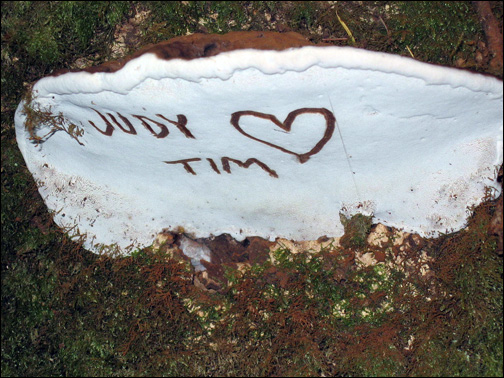
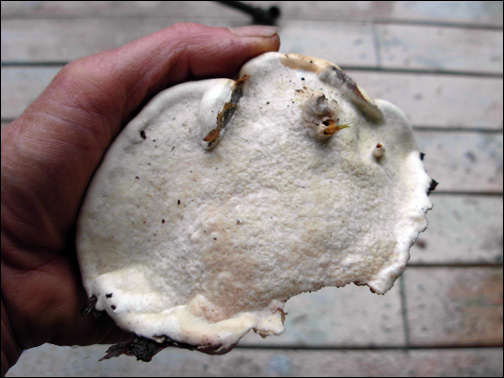
A freshly growing specimen was used. Only a small slice of the outermost lip was pared from the living conk. The outer, shell-like edge was discarded and a slice 1/8 inch thick, ½ inch wide, and one inch long was carefully manipulated in the hands. It was fragile enough to break several times, but produced several pieces of chocolate/ochre-brown Ganoderma amadou. Expansion in size was good. Pieces were velvety, to felt-like and were very flexible. It looked like a darker brown version of Fomentarius amadou. Initially it did not catch a spark, but later, with a little fluffing up with my fingernail, it caught sparks from flint and steel and from flint and macasite.
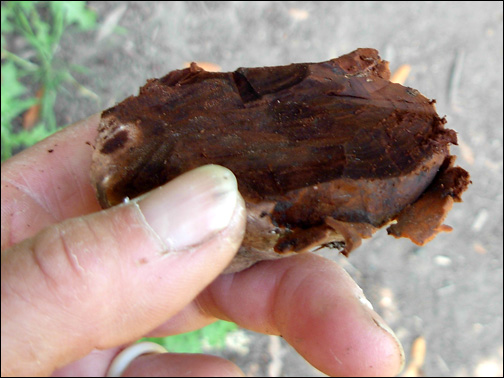
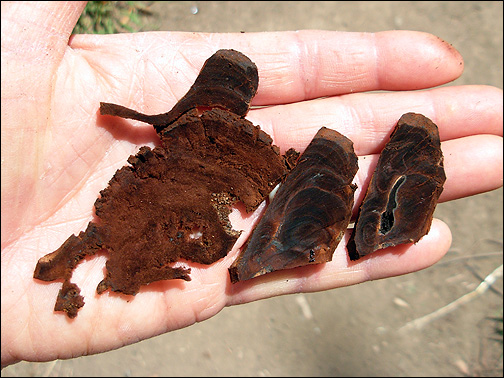
This Ganoderma amadou was placed in a plastic bag. I took it outside with some of my other specimens to try it out again. I noticed that in the sunlight moisture was condensing on the inside of the bag even though it appeared dry. Surprisingly, continued drying didn’t improve its performance.
A second attempt on a larger fresh, growing specimen resulted in what appeared to be a chunk of brown felt. It required lots of slicing to remove pore layers and pounding to produce the felt. (See photo showing pore layer, trauma layer above, and shell like top surface.)
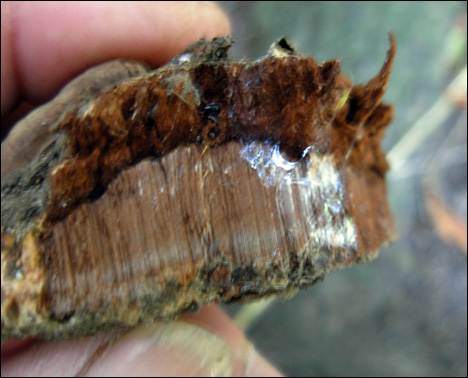
This pounding was far more vigorous than that required to create a felt from the oak conk. Also, this felt didn’t respond much to manipulation with the hands. This thick, but pliable felt did not catch a flint-and-steel spark. I lit an edge to test its flammability and it created a long-burning ember that was difficult to snuff out.
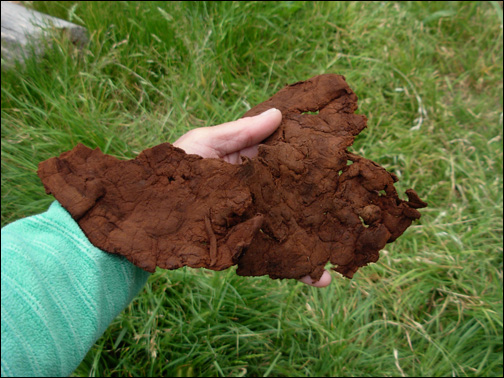
Later, after continued drying, this same piece of a Ganoderma amadou easily caught multiple sparks from flint and marcasite, but again failed to catch flint and steel sparks.
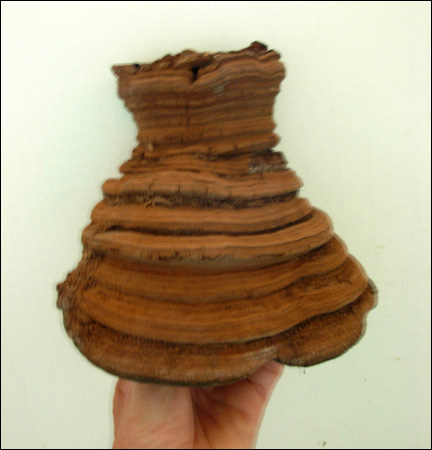
My third attempt was with an old specimen that was not actively growing. It contained many layers. There was no trauma layer between tube layers in this specimen. Although it did produce a decent punk when dried, it never produced successful tinder for catching a spark. I ended up bashing it to smithereens and using the pile of fluffy pieces to make a brown paper. The paper, when charred, made a moderately successful charcloth.
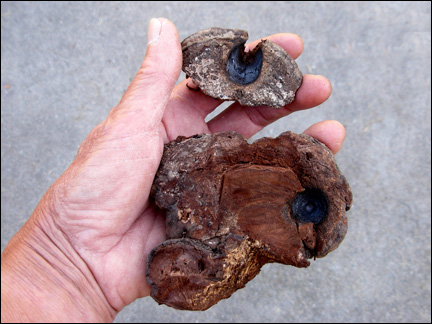
I am told that the underside of artist conk (Ganoderma appalanatum) can be used as a hearthboard for friction fire. Because the pore layer is so full of air, it can be used without a notch.
Red-Belted Conk (Fomitopsis pinicola)
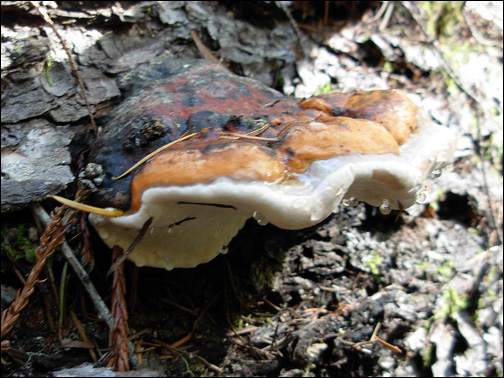
First attempt: My first attempt was May of 2011, with a mature specimen that had fallen from a tree. I did manage to make some poor quality amadou. The color of the Fomitopsis amadou was nearly creamy white to light tan, and it felt like a piece of leather, but more like bark tanned leather than brain tanned leather. Though light and flexible, it was not as soft as Fomes amadou. It only caught sparks reluctantly. This wasn’t what I was after, but might warrant further exploration.
Second attempt: This conk was tentatively identified April 1, 2012, based on shape/size, color, host, and description in David Arora’s book entitled "Mushrooms Demystified".
Young specimens were found on a recently fallen Ponderosa Pine, and were oriented such that fruiting was horizontal to the ground, i.e. evidence fruiting began on the fallen tree. Tube layer tissue was white and did not turn dark when scratched. The tissue had not differentiated itself into clear layers of tube and trauma. The entire inside was white, spongy and thick. Initially I was unable to create pliable amadou from these specimens.
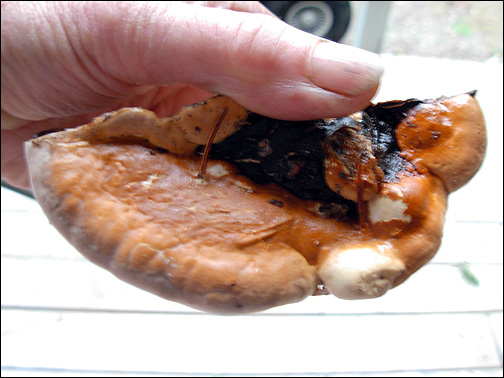
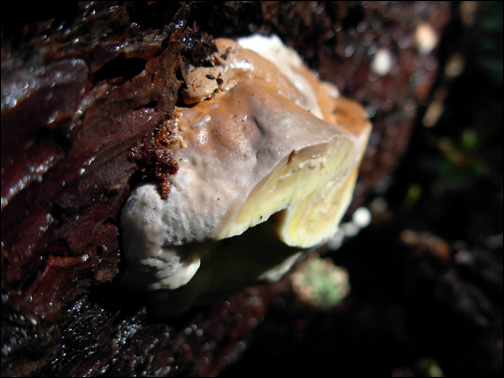
The problem apparently was due to the dampness of the actively growing specimen. It was collected in the rain. The material became sticky with manipulation, and dried out stiff and un-useable. Another immature conk from the same area of the tree was dried for two days. The sliced material from this conk was still slightly damp and had a corky, almost felt-like consistency when sliced. It became fluffy when lightly pounded and manipulated. The young tube layer peeled away from the bottom and was processed as a separate piece, but did not retain flexibility when dried. The area just under the darkest-colored top surface was the most fluffy and pliable, expanding 2-3 times its original size and becoming very light and foam-like. After roughing up the surface of this “white amadou”, it accepted a spark from marcasite and flint, but could not do so consistently, nor did it catch the spark from flint and steel well. In fact, setting it on fire with a match created a flame, but when the flame was blown out, the ember failed to expand. It simply died. Not a promising sign.
Third attempt: I encountered a large white knob of conk tissue growing from a Douglas fir log. A section was sliced off and manipulated. It behaved much like the above specimen, but this specimen was less well differentiated. The ID on such a young specimen was difficult, but my best guess is that it was a young red-belted conk.
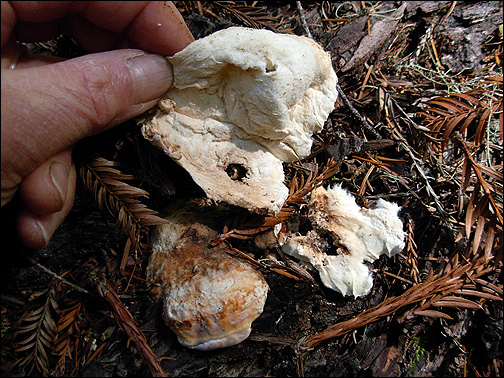
Phaeolus schweinitzii
On April 15, 2012, I found a dry, tiered, fan-shaped fungus on and around a Douglas fir stump. It was not actively growing and was very dark, blackish brown with a yellow ochre-brown flesh. It had a velvety/hirsute top surface and the underside was black with a white dusting of either spores or, more likely a mold. This underside seemed to have very course or decomposed pores appearing almost like black terrycloth.
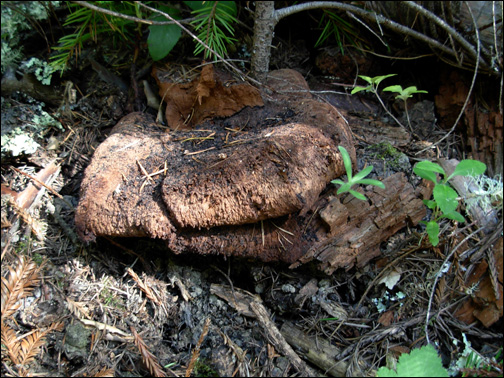
I am not an expert on fungus identification, and had never seen this species before. This specimen was not fresh and growing. It most resembled Phaeolus schweinitzii (also known as dyer’s polypore,) but it didn’t produce an obvious dye pigment in hot water. Also, the characteristic fused pores of Phaeolus were not clearly evident in this old specimen. I sent it to Philip Carpenter, a local fungophile with considerable knowledge, and he put it under the microscope. Phaeolus schweinitzii was the positive ID.
Because this species has a stype, and doesn’t necessarily grow shelf-like from the side of a tree, I suppose it’s not really considered a conk. It is, however, a wood-rotter that persists after its growing season is over. It probably was the reason for the host tree’s demise. My attempts to make amadou from it failed, but the unprocessed trauma layer of the fungus caught sparks nearly as well as chaga, so it deserves a place in the tinder kit.
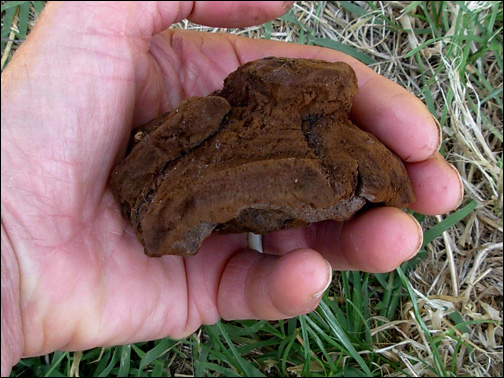
The tissue just under the pores was light like a fine-celled rigid foam, but showed fibers originating at the attachment portion and radiating to the edge. This material did not expand when sliced wet and manipulation. Dry, it was as light as pumice and quite brittle. But its light and airy texture made me think it a likely candidate for catching a spark. First attempts were unsuccessful as the sparks tended to bounce off. If touched to a flame it held even very tiny embers well, expanding and resisting attempts to smother it. After roughing up the surface with a fingernail, this fungus readily caught and held sparks from flint and steel on the second or third pass.
Per Robert A. Blanchette, Professor from the Department of Plant Pathology at the University of Minnesota, Phaeolus schweinitzii was indeed used for tinder by at least one group of Native Peoples in Alaska. The sample is in the Field Museum of Natural History in Chicago. Collection #78754. Collected by Lieutenant G. T. Emmons in the late 1800's and sent to the museum in 1901. The collections notes are a bit hard to read, but this is what I have: "Tinder for fire making. Consisting of a fungus growth of the spruce tree . . . . the spark in the checking of flint and iron . . . . to produce fire. Admiralty Island, Hootz-ar-tar-tribe." Professor Robert L. Gilbertson, a mycologist from the University of Arizona and I identified this collection as Phaeolus schweinitzii.
Unsuccessful Attempts at Producing Amadou
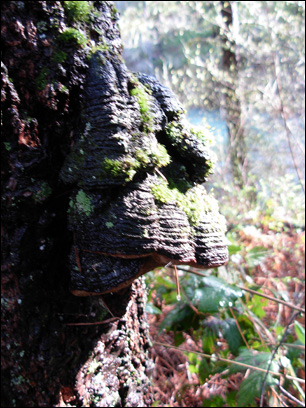
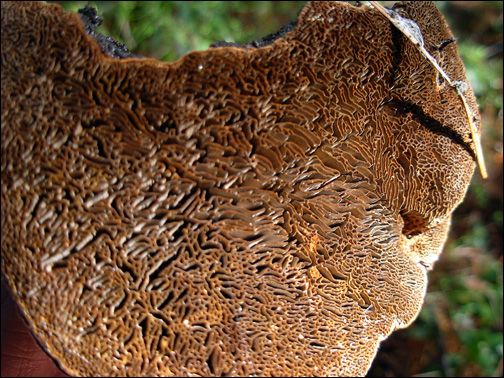
Pine Conk (Phellinus pini): On March 3, 2012, identification was based on shape/size, sinuous pores, host, and description in David Arora’s "Mushrooms Demystified".
Several old specimens were found on a living Douglas fir. They were sliced concentrically on a vertical plane. Several layers of tubes were encountered, but no trauma layer was present. No further attempts were made to make amadou from this specimen, though when dry it probably would be acceptable as a punk.
A second try with another pine conk also proved fruitless. These older specimens were quite brittle.
YouTube videos on substitutes for tinder fungus by Susan Labiste:
Conclusion
My explorations with shelf fungi merely open the discussion. The only real conclusion is that shelf fungi, and perhaps other fungi, offer considerable opportunities for tinder-making, and that the much prized “tinder fungus” (Fomes fometarius) and the other fungus also sometimes called “true tinder fungus” or chaga (Inanotus obliquus) are just two of many “tinder fungi”. Consider too that most shelf fungi can also be used as a punk, slow match, a coal extender or be burned in a low oxygen environment to produce a char used like charcloth. The pore layer of many can serve as a wick in your fat-lamp. The underside of your conk may make a good hearth-board for a friction fire. It is my hope that this article will encourage others to experiment with their local conks, publish their results, and help rebuild a working knowledge of “tinder fungi”.
![]()
Photographs by Susan Labiste. All photo rights reserved.
We hope the information on the PrimitiveWays website is both instructional and enjoyable. Understand that no warranty or guarantee is included. We expect adults to act responsibly and children to be supervised by a responsible adult. If you use the information on this site to create your own projects or if you try techniques described on PrimitiveWays, behave in accordance with applicable laws, and think about the sustainability of natural resources. Using tools or techniques described on PrimitiveWays can be dangerous with exposure to heavy, sharp or pointed objects, fire, stone tools and hazards present in outdoor settings. Without proper care and caution, or if done incorrectly, there is a risk of property damage, personal injury or even death. So, be advised: Anyone using any information provided on the PrimitiveWays website assumes responsibility for using proper care and caution to protect property, the life, health and safety of himself or herself and all others. He or she expressly assumes all risk of harm or damage to all persons or property proximately caused by the use of this information.
© PrimitiveWays 2016